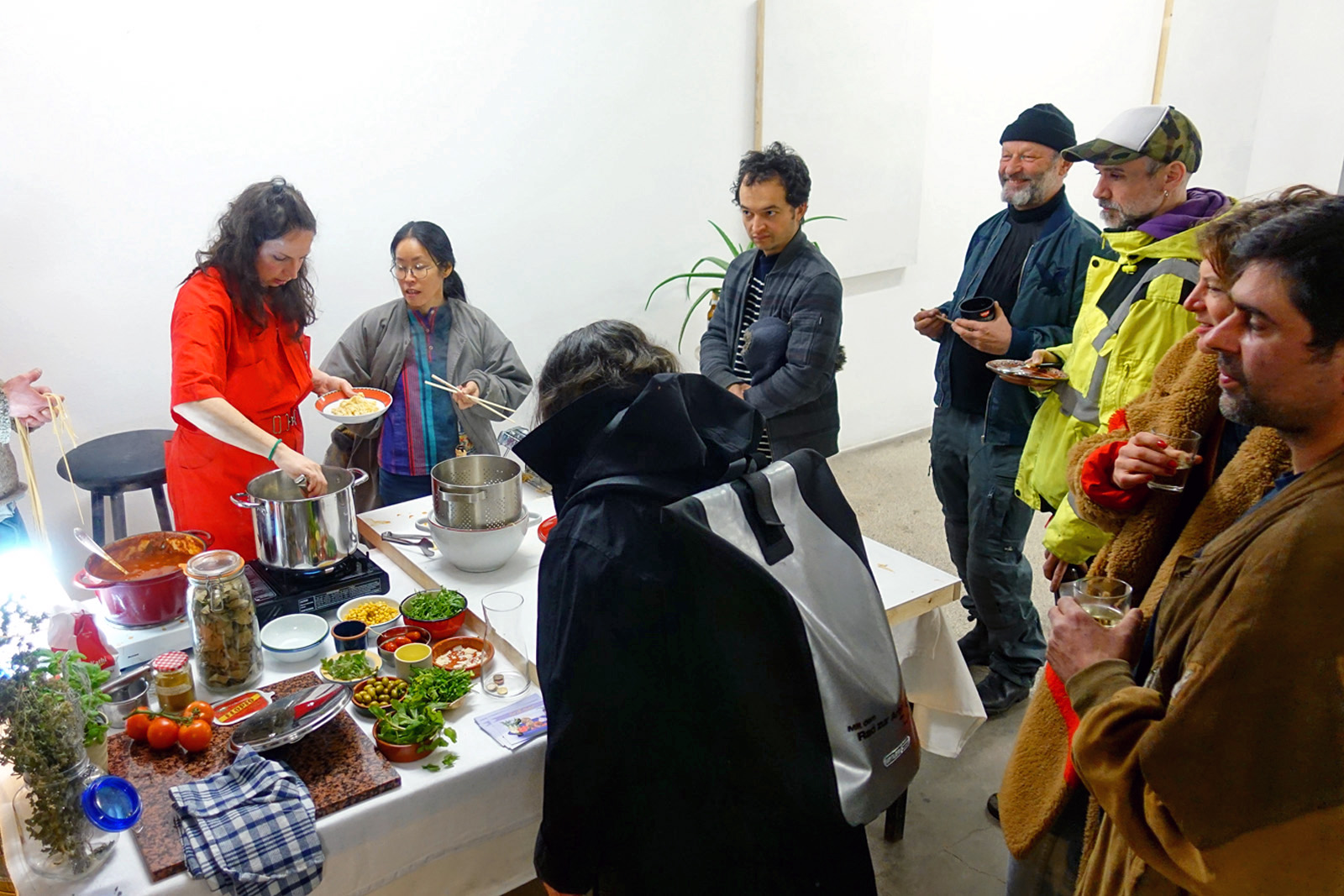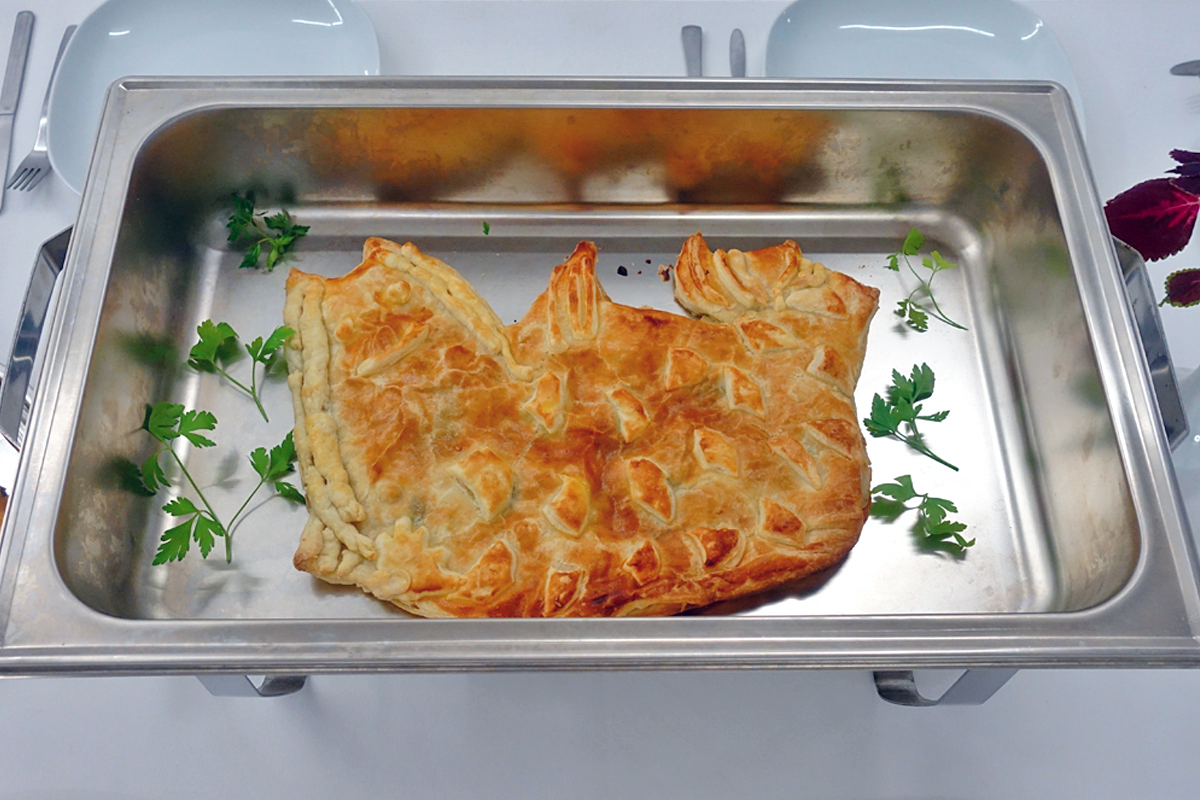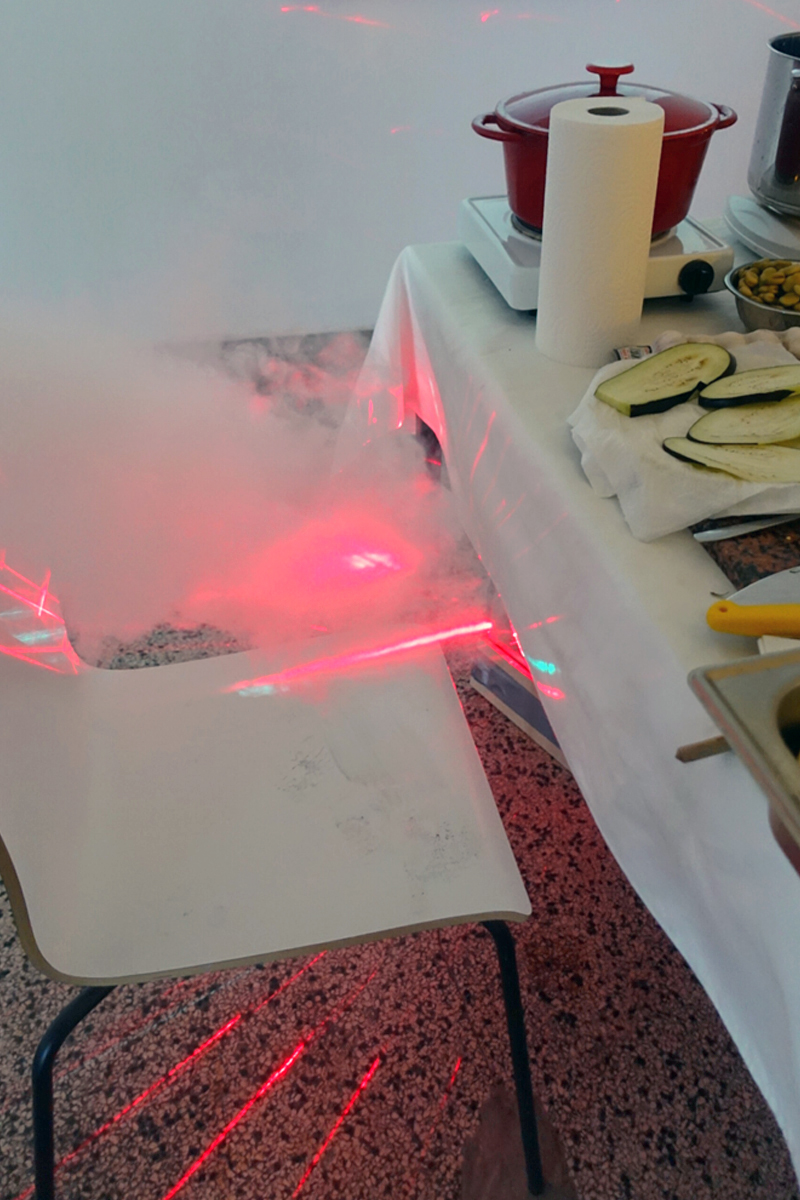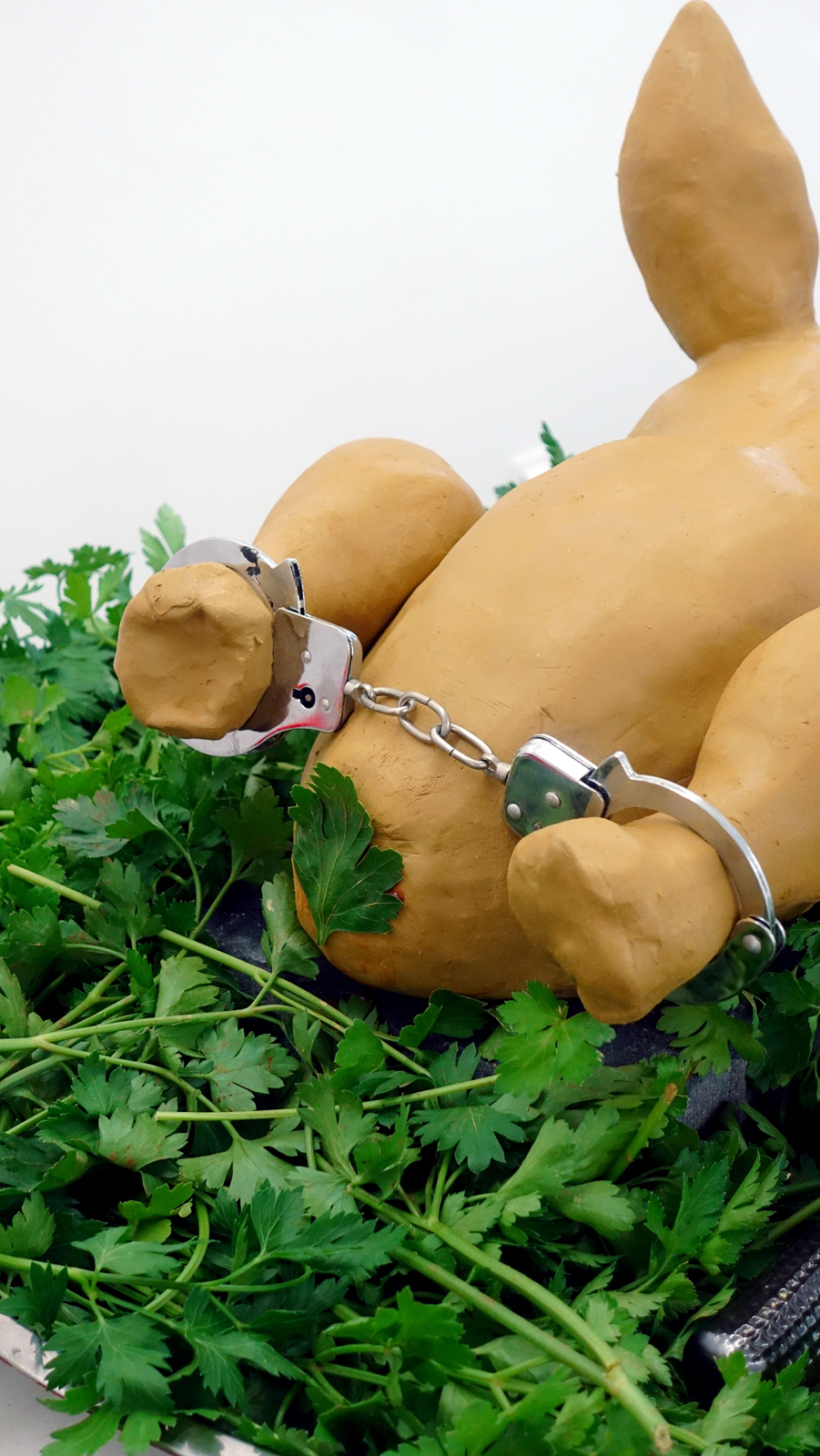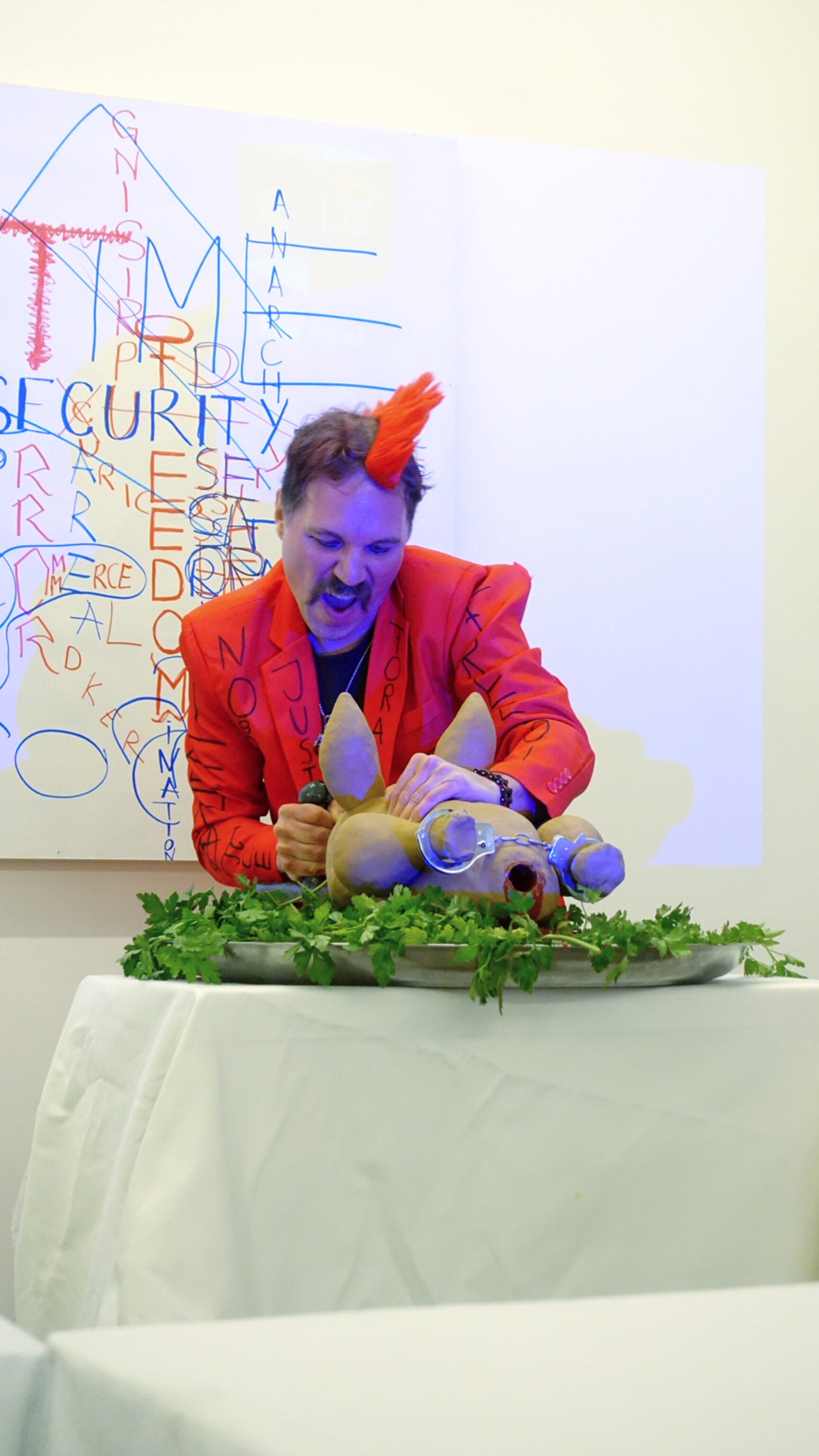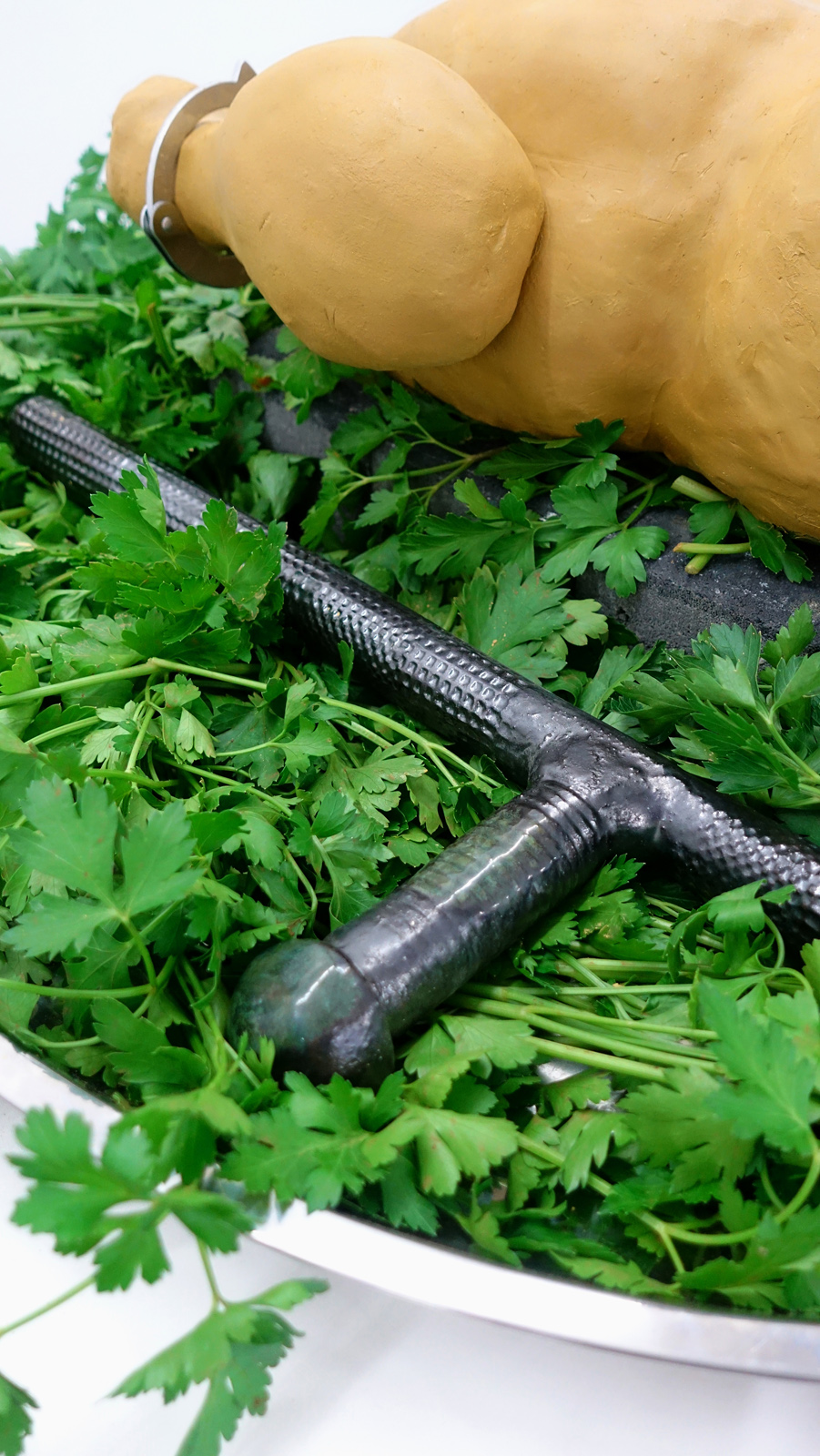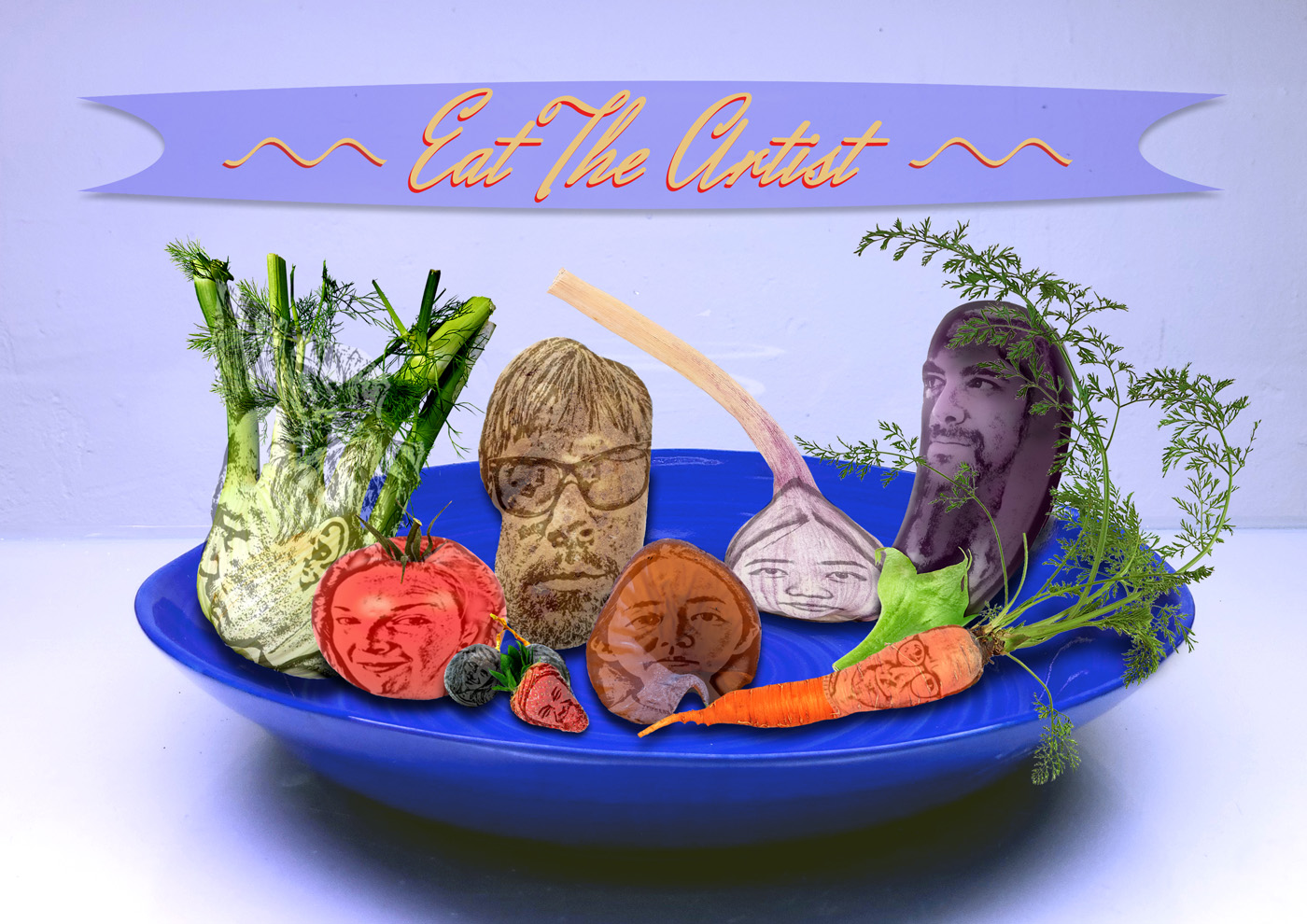

as part of
the first edition of
Sellerie Weekend Berlin
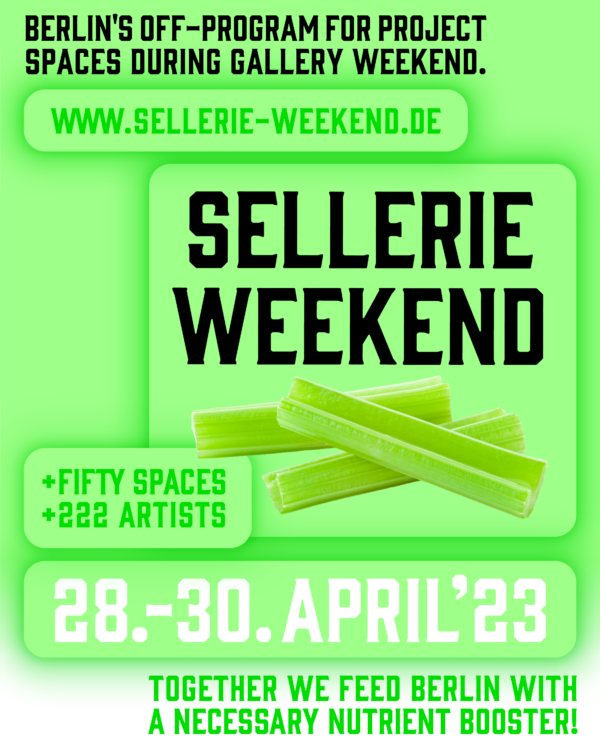
with culinary and artistic contributions by
Çağdaş Çeçen
Laura Fiorio
Bhima Griem
Tomoko Mori with Johannes Rodenacker
Marco Schmitt
Xiaoyu Tang
as part of
ICH ICH ICH @ Kunstpunkt Berlin
together with Crystal Ball
14.-30.04.2023
Kunstpunkt Berlin
Schlegelstraße 6
1st backyard
10115 Berlin-Mitte
About ~ Mobile Menu #14 - Eat The Artist ~:
stay hungry presents Mobile Menu #14 - Eat the Artist, a culinary intervention series with contributions by the artists Çağdaş Çeçen, Laura Fiorio, Bhima Griem, Tomoko Mori, Johannes Rodenacker, Marco Schmitt and Xiaoyu Tang at Kunstpunkt Berlin on the occasion of the exhibition ICH ICH ICH.
The genius as a talented individual figure is opposed to the idea of swarm intelligence, and to this day minds are divided on the question of whether the individual can be replaced by collective practices. At the center of the conceptual idea of Mobile Menu #14 - Eat The Artist is the questioning of the (self-) perception and self-staging of artists in a world that is becoming increasingly competitive in all areas. The concept of the artist as genius, as a single, talented individual can be critically questioned. Based on these thoughts, stay hungry developed Mobile Menu #14 - Eat the Artist to explore this debate in a culinary and artistic way through a multi-part intervention series at Kunstpunkt Berlin, which will take place twice a week on Fridays and Sundays from 14.-30.04.2023.
On each date one of the six invited artists is asked to create a culinary self-portrait for one evening, which emergence can be observed and in part actively shaped by the visitors and which will then be offered for communal consumption.
The artists are called upon to artistically and culinary comment on these topics through their interventions and to open up possible new perspectives.
Please watch out for our upcoming newsletters and Instagram content for detailed information about each culinary intervention!
No RSVP needed!Free food!Donations appreciated!
Come by to eat and meet the artists! 🙂
Friday, 14.04.23, opening, 7-10 pm
Eat The Artist #1
Laura Fiorio
Meins, Meins, Meins!
Der Kampf der Tradition und die stille Rache
der singenden Tagliatelle Armee
Feel free to bring your favorite pasta ingredient and add it!
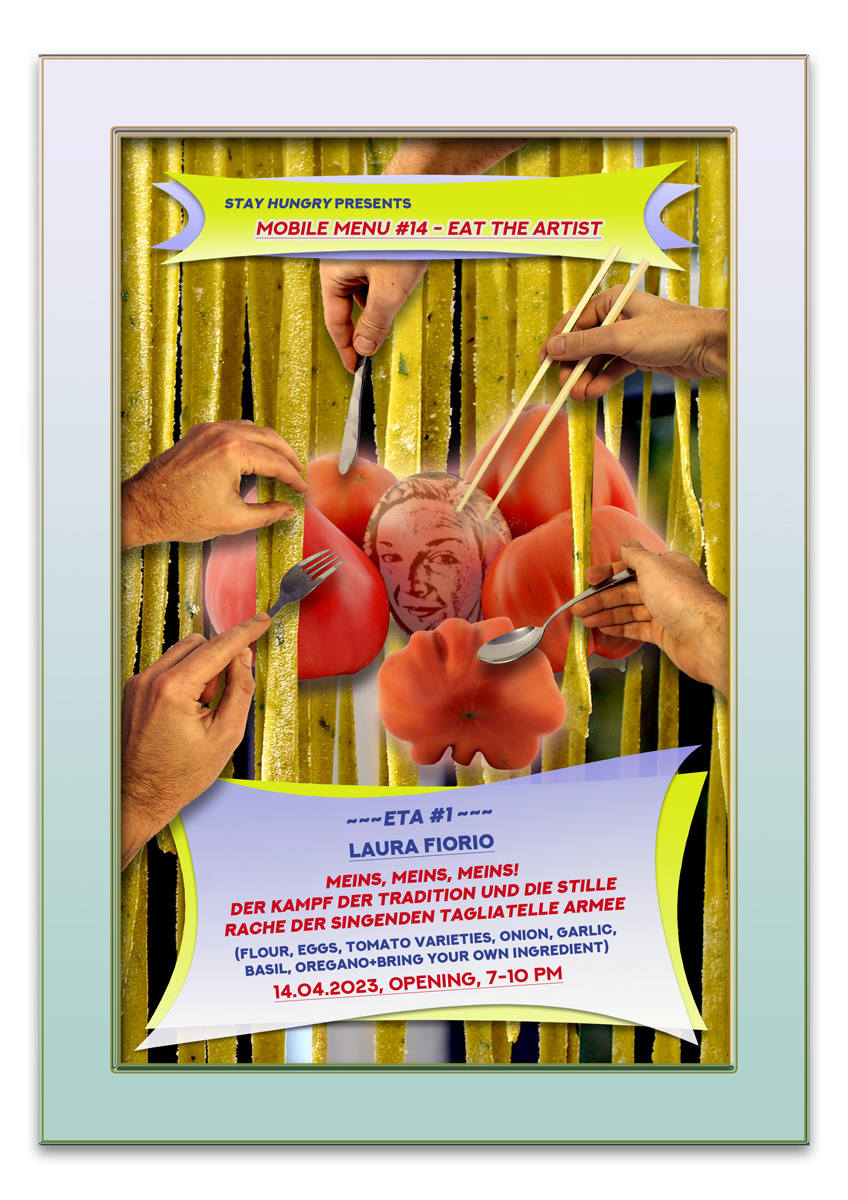
Italian culinary tradition is defended with pride and competition in kitchens all over the boot. Disputes over who is in possession of the authentic recipe that contains the truth about the purity of traditional ingredients are not uncommon.
Historically and contemporarily, the Italian government has consistently emphasized the value of "Made in Italy" as purely Italian and promoted the modernization of agricultural production in the early years of the century, while more recently turning a blind eye to the mob-like enslavement of migrants in the tomato harvest.
Against competitive thinking and the defense of alleged traditionalist dogmas, we want to propose an evening of cooking together, remembering that traditions are born together, evolve fluidly, and grow and multiply in mutual dialog rather than in the clash of cultures.
We will present a basic recipe for home-made tagliatelle rosso, to which guests can add ingredients as they wish, following the motto: free to experiment with any flavor, as long as it is their own portion! Surprising ingredients for culinary variations galore.
Everyone is invited to bring something: The tomato comes from America!
Sunday, 16.04.23, opening, 3-7 pm
Eat The Artist #2
Tomoko Mori with Johannes Rodenacker
Ningyo Pie
~Japanese Puff Pastry Mermaid~
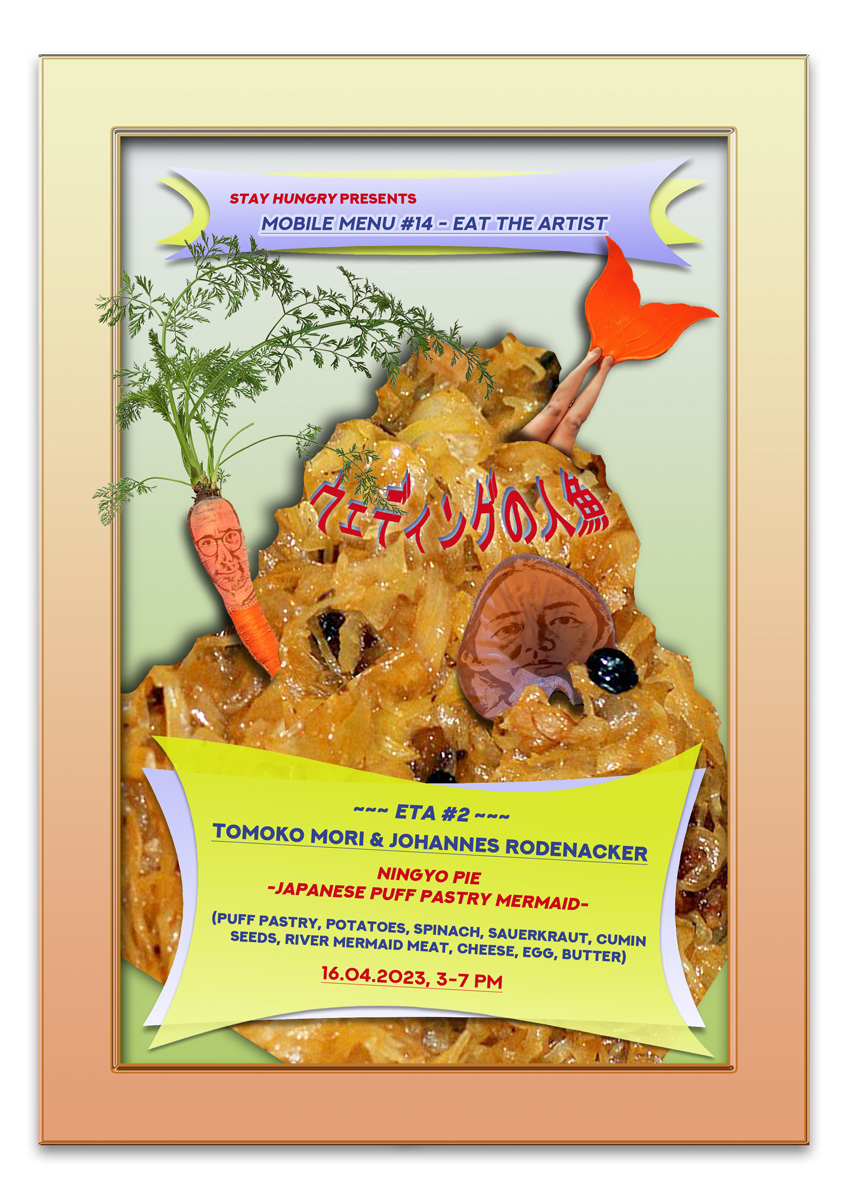
From myth to meal
In 1882, a rumor spread that a river mermaid had been spotted in the Panke River at the district of Gesundbrunnen.
After the healing spring at Gesundbrunnen mysteriously dried up that same year, a series of articles appeared in local newspapers over a period of weeks linking the drying up of the spring to the sighting of the mermaid.
At the time, this urban legend became the number one topic of conversation in Berlin. As it turned out a little later, the story had been pitched to Berliners to distract from the fact that canal work had actually led to the spring running dry.
The Japanese writer and scientist Kotaro Mori, who lived in Berlin around 1900, wrote a tongue-in-cheek article about the mermaid from the Panke in the Tokyo Shimbun and also revealed the real reasons for the spring's drying up which was the progressing industrialization and its consequences.
It was precisely the combination of fairy tale and Berlin reportage that appealed to the Japanese public, which was always thirsty for exotic news from faraway lands. Thus, the story of the mermaid from Berlin quickly developed a life of its own in Japan. A restaurant in Yokohama took the opportunity to develop a dish made of puff pastry in the shape of a mermaid, which quickly became very popular. According to a Japanese myth, eating mermaid meat makes you immortal, and so this dish became a popular dish that is still prepared at home for "old people's day." Each family is very proud of its own variant of the recipe and every year, amateur cooks present their results at local competitions and on a national TV show called Everybody's a Cook.
JDSI
The Japanisch-Deutsche Sprichwörterinstitut (Japanese-German Proverbs Institute) is a project by Tomoko Mori and Johannes Rodenacker. It is dedicated to the translation of proverbs and their transposition into images. The handed down wisdom and sayings provide the starting point for an artistic cultural exchange in the field of tension between misunderstanding and found in translation.
Friday, 21.04.23, 5-9 pm
Eat The Artist #3
Çağdaş Çeçen
BYTE THE PURPLE
~Some say eggplants are too bitter and tough,
but I think they're just right - I like it rough!~
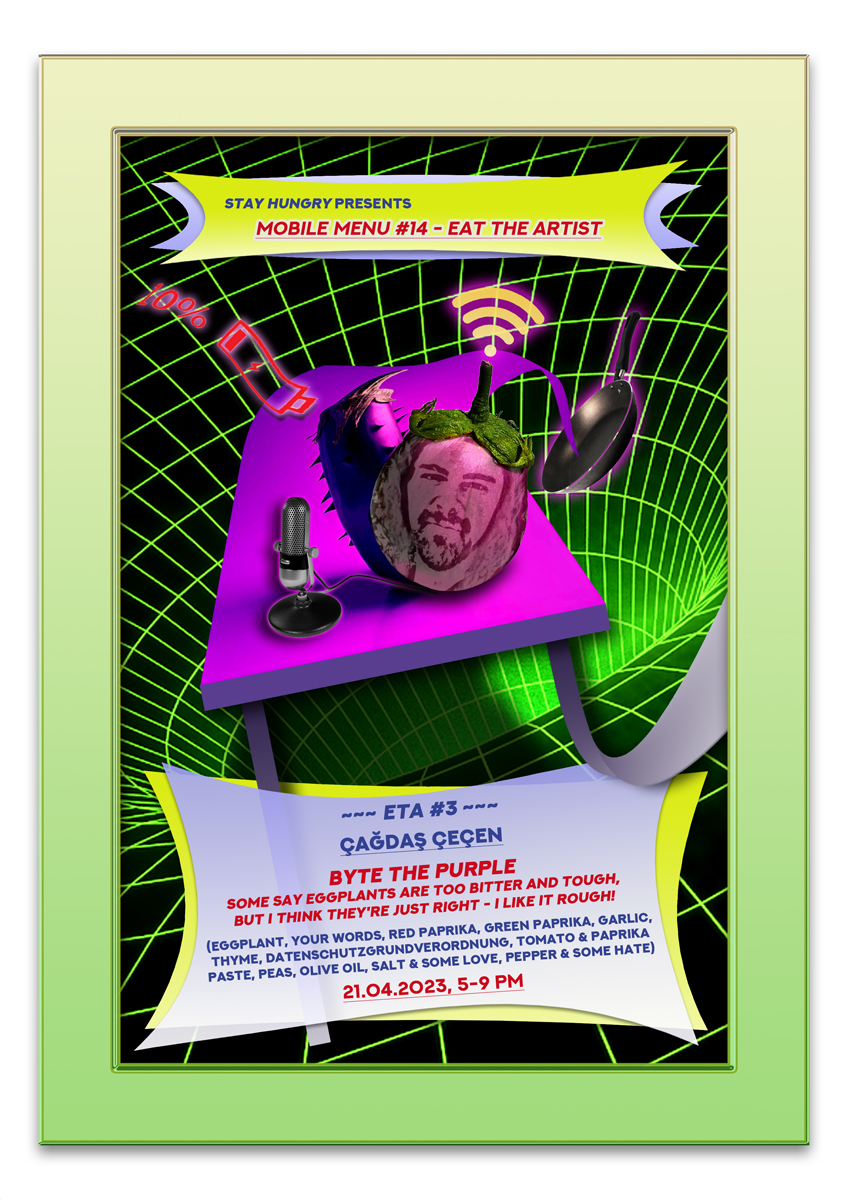
Life is a journey of transformation, for both humans and eggplants. At birth, we are born with an unblemished canvas, ripe for the brushstrokes of experience and perspective to paint a complex and multidimensional portrait. Just as the perfect seasoning coaxes out the eggplant's nuanced flavour, our unique life experiences and perspectives shape us into fully-realized individuals. Similarly, the evolution of the eggplant and the world of artificial intelligence may seem like unlikely companions, but they share a common theme: growth and development.
The eggplant's bitter taste can be harmonized with the right blend of companion ingredients, while AI algorithms can be optimized and refined through data and inquiry. The application of both can be fine-tuned by asking questions and applying experience.
During the performance, an open microphone will be available for you to engage with an Open AI system, ask an innocent question at the beginning and see where it goes until the end; with each question, the conversation will evolve, and the topic will expand.The performance will overlap layers of experience and development among food, human and AI. The eggplant's subtle smoky aroma is reminiscent of the mysterious and unexpected, much like the enigmatic nature of life and development itself.
Sunday, 23.04.23, 3-7 pm
Eat The Artist #4
Marco Schmitt
Roasted Polizei-Huhnd
~cluck cluck-woof woof~
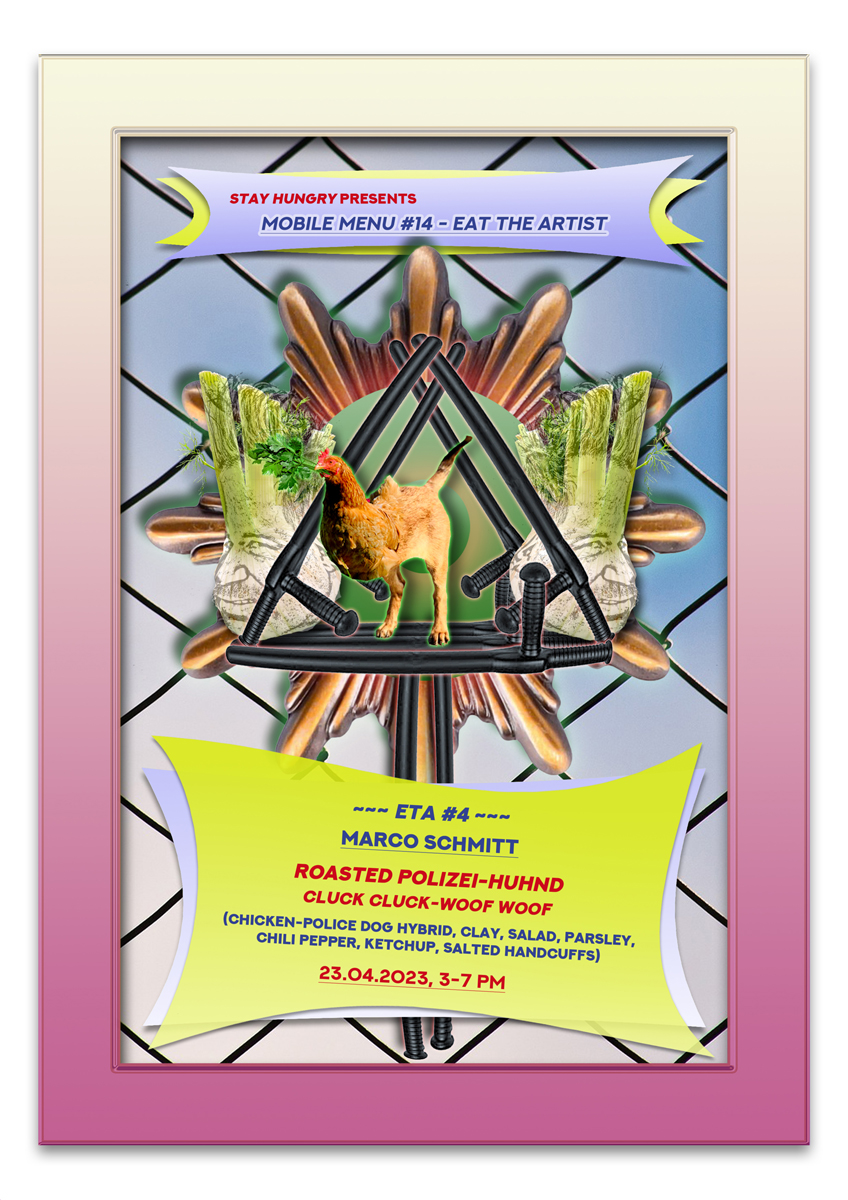
On the occasion of Mobile Menu #14 - Eat the Artist 4, a so called Roasted Polizei-Huhnd whose hybrid appearance results from the fusion of a chicken and a police dog, will be served to the mental hunger of the audience. While the chicken with its red Mohawk can be seen as a natural born punk, the police dog is equipped with a baton tail.
It all started somewhere in a comatose techno-feudalistic cage where the chicken laid eggs that were cracked by the police dog's baton tail. The Polizei-Huhnd is ready for the R-Evolution of plasticity. It will be sacrificed to the appetite of the audience and thus is reincarnated in collective diversities. The echoes ring back into the future: cluck cluck wuff wuff cluck cluck ruff ruff cluck cluck arf arf.
As a crowning finale to the hybrid presentation, the video work Xterminating Badges by Marco Schmitt will be shown at 6 pm. Five police officers from the Zurich Cantonal Police play the main characters in Schmitt's cinematic reinterpretation of Luis Buñuel's surreal classic El ángel exterminador. Xterminating Badges was produced in 2016 on the occasion of Manifesta biennial 11 in Zurich/ Switzerland.
Friday, 28.04.23, 5-9 pm
Eat The Artist #5
Bhima Griem
Kill The Galleries
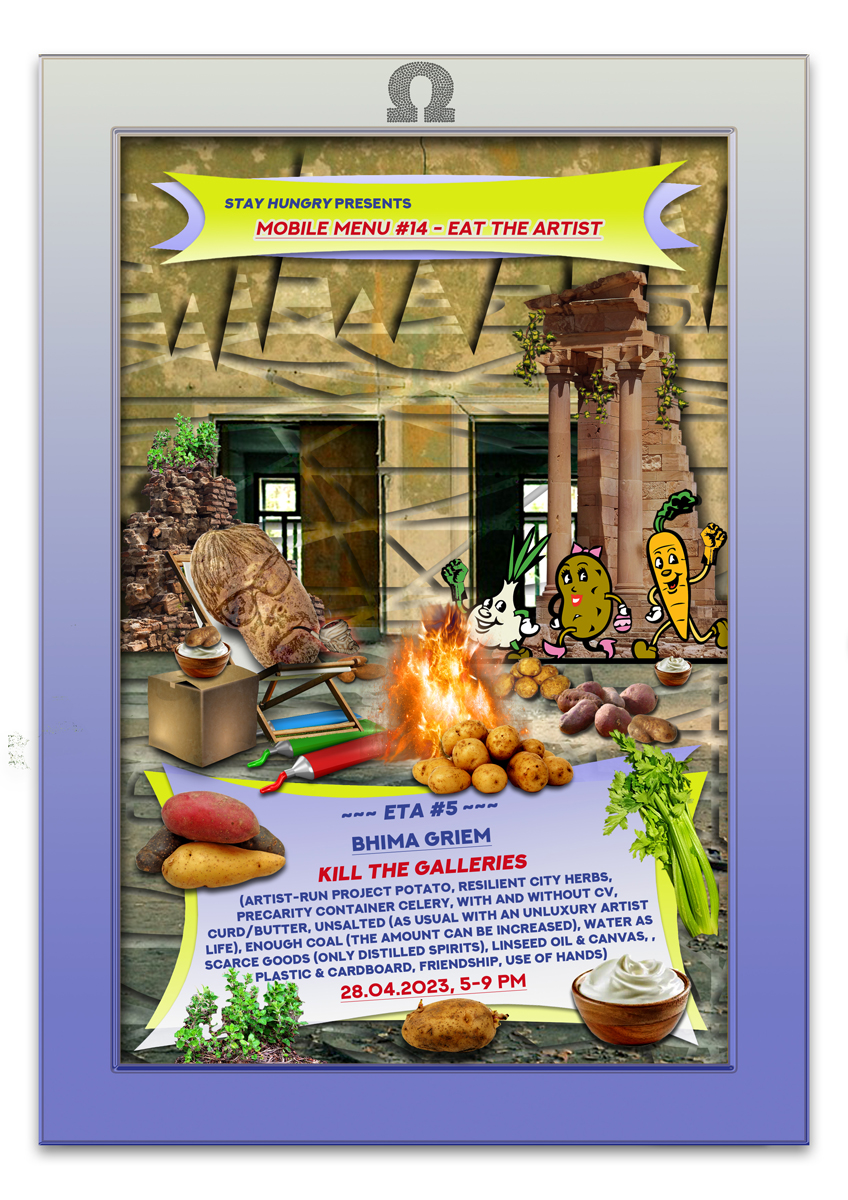
Are the galleries abolishing themselves?!
The most active and productive art spaces are currently the artist-run spaces, residencies, seminars, etc... and everything beyond.
Will artists be able and willing to take care of themselves and their colleagues in 2023? Will the artists regain a self-confidence they thought they had lost?
Exploitation and exclusion by the culture industry has given rise to parallel networks. For me, 2023 stands under the theme of friendship - unconditional friendship - that is independent of status and power.
Enough with the precarity! This is a call for gang-building, solidarity and support among us artists!
Bhima Griem-2023-BestFriend
PAST EDITIONS:
Sunday, 30.04.23, 3-7 pm
Eat The Artist #6
Xiaoyu Tang
Garlic Occupies The City Project
~We are all garlic!~
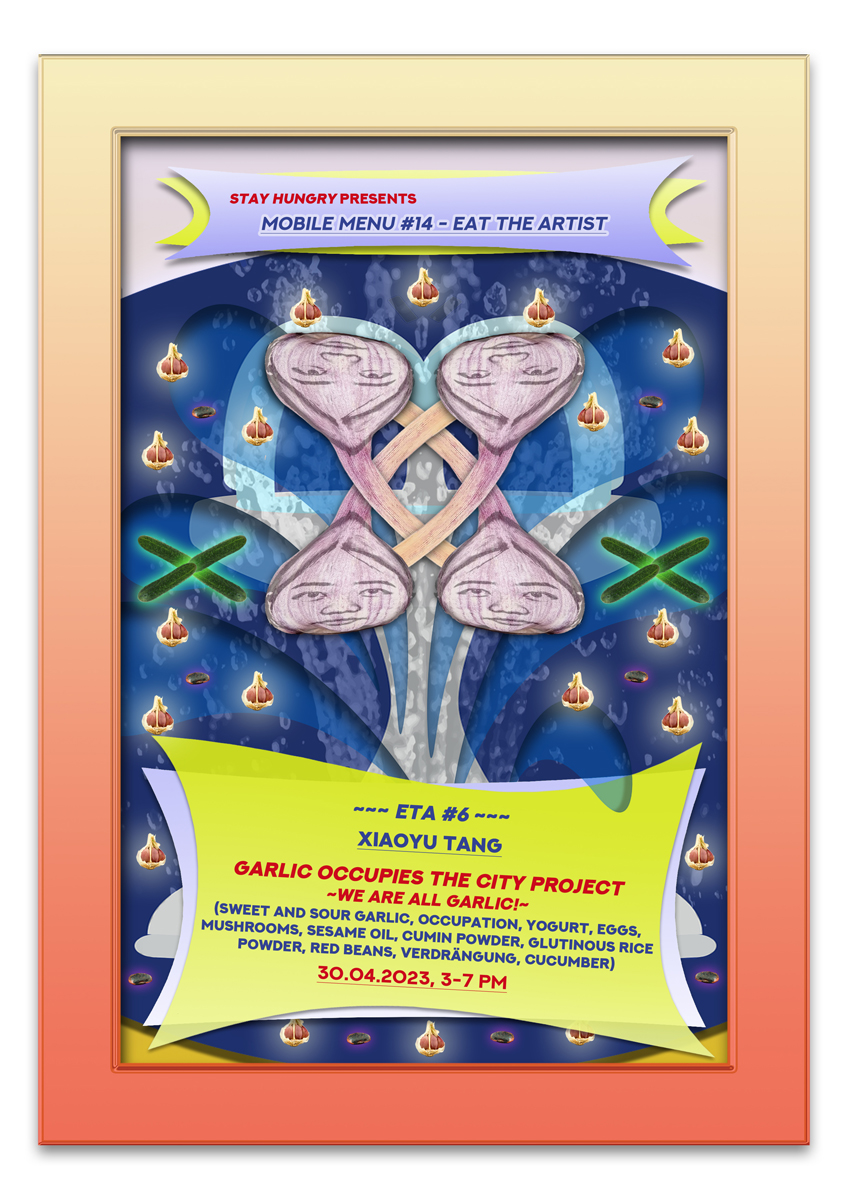
,,When I was a child, I was often told that my nose had a shape similar to that of a garlic. Because of this, my mother and I went to a plastic surgeon. He said all I had to do was to get silicone implants put in the tip of my nose to make it look better. Although we did not follow the plastic surgeon's advice, the word garlic and the shape of my nose have stayed with me for the whole of my life until today. We get along well and I even feel, that my pretty garlic nose has been given a special mission by a mysterious power. So please don't be surprised if I appear as garlic!''
In a market economy interest of fast and optimized production garlic today is cultivated from cloves which results in its loss of the natural ability to reproduce sexually. This strongly limits the genetic diversity and adaptability and may eventually lead to the extinction of the species.
Fortunately, this trend can be reversed by growing garlic from seeds again.
Food can act as a mediator of expanded perception and bring us closer together. We question our environment through food, people and space. In this specific case the garlic thus becomes a 'food scape', which means a place, a scene of activities that include socio-cultural, political and economic aspects. However, the fictional city scape of “everything is moving too fast" displaces other identities, relationships, and memories.
During the intervention Garlic Occupies the City Project visitors can participate in an interactive game in which they are invited to discuss the survival strategies of the garlic in a new and together composed fairer city scape, while pickled garlic cloves are offered for consumption at the same time in the installation architecture.
Mobile Menu #14 - Eat the Artist
timeline:
Laura Fiorio: Fri, 14.04.23, opening, 7–10 pm
Tomoko Mori & Johannes Rodenacker: Sun, 16.04.2023, 3–7 pm
Çağdaş Çeçen: Fri, 21.04.23, 5–9 pm
Marco Schmitt: Sun, 23.04.23, 3–7 pm
Bhima Griem: Fri, 28.04.23, 5–9 pm
Xiaoyu Tang: Sun, 30.04.23, finissage, 3–7 pm
@ KUNSTPUNKT BERLIN
Humans' preoccupation with the self is as old as humankind. The mysterious hand prints of the cave paintings in Spain, Indonesia etc. and various ancient examples of busts as self-portraits already refer to an everlasting confrontation of humans with themselves in relation to the environment. This topic and all reflection and reception connected to it are manifested in the history of art in the sujet of self-portraits as paintings or sculptures.
With the rise of the Renaissance, in contrast to the Middle Ages, artists were no longer simply commissioned by a superior institution. They worked on developing their own style (from Italian: maniera) and their own artistic signature. In this period, the self-confident artists had no longer the feeling of belonging to the mere handcraft. They emancipated themselves as artistic personalities and considered their discipline as equal to those of philosophy, literature and science.
Artists used the subject of the self-portrait for setting up a monument to themselves. They took themselves as a quickly available and cheap model to study the interrelationships of human physiognomy and anatomy. At the same time, the classical concept of the term genius developed. From then on a genius is described as a person, that is a generally learned individual talent who possesses knowledge, creativity and ingenuity and is trained in cultural-spiritual as well as scientific fields of research.
The Age of Enlightenment marked the beginning of a new era for the concept of genius, that was fundamentally changing the self-perception of artists. People now no longer saw themselves as beings, whose lives were fated on earth and in heaven, but rather as a self-determined spirit who abandoned preconceived ways and questioned their rules. The phrase of the artist as a genius was born. At the turn of the 17th and 18th centuries, a heated literary controversy erupted in France, which resulted in creating the concept of genius. It abruptly spread and dominated aesthetic debates. On the one hand, the term genius now stood for artists creating out of themselves, who didn't imitate nature only (as the earlier aesthetic model had done), but who broke boundaries of the rationality of nature in their work. In addition to the analytical view of the external appearance, many self-portraits testify to the artist's inner confrontation with himself, with his own changing moods and his own transience. On the other hand, the term genius was used to describe a person who possessed a gift or talent that was innate only to him or her personally. Kant speaks about the creative genius and says only an artist and no scientist can be one. He calls it eigenthümliches Genie, which creates entirely out of itself and establishes its own rules. He derives the peculiar (Das Eigenthümliche) from property or intellectual property belonging to the creator. Later he will revise his theory again.
The invention of photography in the 19th century radically changed the mostly exclusive use of (self-) portraits until then. It paved the way for a new era of pictorial language and dissemination, which continues into our own time and is still in a constant process through digitalization. In the course of the 19th century, moreover, the idea of the cult of genius steadily declined, and in the wake of this, the concept of the self-portrait and its perception moved further away from its original, mostly representative, meaning over the course of the 19th and 20th centuries. Developments in art, culture, and society influenced by modernism and postmodernism further deconstructed the concept of genius. Between briefly flaring up new cults of genius, new collective approaches to working and living together also emerged, which were critical of the individualization and prominence of individuals.
The concept of the artist as genius, as a single, talented individual who creates from within himself or herself, has been questioned ever since. The genius as an individual figure is opposed to the idea of swarm intelligence, and to this day minds are divided on the question of whether the individual can be replaced by collective practices.
Based on these thoughts, the project Eat the Artist was developed to explore this debate in a multi-part culinary intervention series that will take place twice a week every Friday and Sunday from 14th to 30th of April 2023.
The project Eat the Artist was conceived for the exhibition ICH ICH ICH organized by the Netzwerk freier Berliner Projekträume und -initiativen e.V. and will be presented at Kunstpunkt Berlin together with the contribution of the project space Crystal Ball.
ICH ICH ICH questions the artist's self-image and its staging against the background of the current situation in all areas of society. Competition versus solidarity, which is the better (survival) model? Thanks to self-reflection, ironic refraction and the multiple thematization of the topos, the image of the artist as a "genius" now seems obsolete. Or is a certain egomania simply part of the job as an indispensable prerequisite, or sometimes also as a professional deformation?
Mobile Menu #14 - Eat the Artist is also part of the program of the first edition of the Sellerie Weekend with its last two culinary interventions on the last weekend of April.
with friendly support by:


